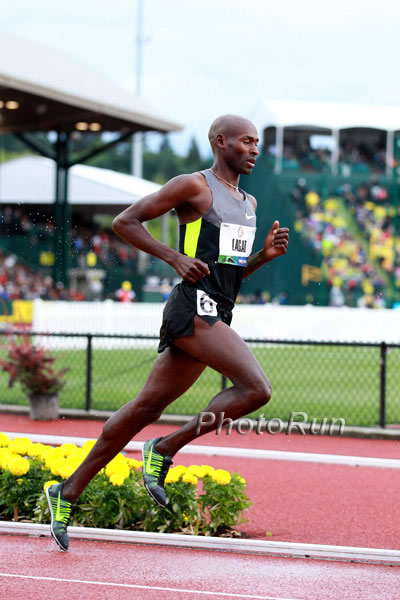Dick Patrick wrote his piece on Bernard Lagat and the 5,000 meters. Dick told me at dinner on Wednesday night, “This article is about Bernard. Please get it posted as soon as possible. It should be read before the 5,000 meter on Thursday night.”
We ask you to pass this one around. The bottom line is this. For Bernard Lagat, all of 36, this 2012 Olympic Trials is his road to London. This is, probably, his last Olympics. For Bernard, there is some urgency, and some pressure as he takes on Lopez Lomong, Galen Rupp and Andy Bumbalough, to name a few.
Our guess? Bernard Lagat should make the team and in London, it should be Lagat, Farah and a few others, fighting for the medals.
Lagat is tough. He just ran 3:34 to win the 1,500 meters at the adidas GP, on June 9. In less than 24 hours, it will come to the final of the 5,000 meters, and we will know, if Bernard Lagat makes the 2012 US Olympic team.
By Dick Patrick
EUGENE, Oregon
June 27, 2012
At 37 and a world-class middle-distance runner for 13 years, Bernard Lagat has been forced to make concessions to age. The Kenyan turned American, who has Olympic silver (2004) and bronze (2000) medals in the 1,500 meters, no longer considers himself a miler.
That idea was confirmed three weeks ago when he finished 14th in the mile at the Prefontaine Classic in Eugene. “I felt like, ‘Am I in the race or not?'” said Lagat, once known for pushing the pace. “It’s one of those things I can’t do now.”
So, after years of doubling at major international meets and U.S. championships, Lagat is running only the 5,000 at the U.S. Olympic Track & Field Trials, which resume Thursday with the 5,000 final after consecutive rest days. He’s a heavy favorite to make his fourth Olympic team, his second for the U.S., in a race that includes promising young talents such as Galen Rupp, 26, coming off a win Friday in the Trials 10,000, and Lopez Lomong, 27, a 1,500 runner who has moved up in distance. The field also includes Lagat’s younger brother, Robert Cheseret, 28.
It’s the differences in the expected contenders’ styles more than age that could result in a suspenseful race. If Rupp pushes it early, can Lagat and others go with him? If it turns into a slow, tactical race will Lomong be able to outkick everyone?
Lagat has always had answers, enabling him to be a threat to win if the race is slow or fast or if he runs from the front or the rear. Though his 1,500 abilities have diminished, his confidence at 5,000 has not. He and James Li, his coach for 16 years, have imagined various race scenarios and trained for them.
“Coming here I feel like I’ve been training very well, at about 90% now,” said Lagat, who has resided in the U.S. since 1996 when he attended Washington State and became a U.S. citizen in 2004. “I don’t want to be at the peak now. If I’m training at 90% and can use all the strength and speed I’ve built, I feel comfortable going in there and executing it well. It doesn’t matter the kind of race it’s going to be, I’m going to be ready. If it’s going to be fast or slow, I’ll be in the mix and make sure I’ll just run strong.”
Lagat has a sense of urgency. He says there won’t be any Olympics for him after 2012. Despite his glittering resume – seven U.S. records, the two Olympic medals, six world championships medals including the 1,500/5000 double gold in 2007 – he considers his lack of an Olympic gold a glaring omission.
“I want to make this team,” he said. “When I make this team, I just want to run for the gold. There’s nothing else. I’m not going to run for the second spot. (Gold) would define me. Did I do the best? Yes, if I win. If I didn’t get it, well, I tried.
“I’ve been on this journey for a long time and (the Olympic gold) is something that has been missing. Along the way there have been ups and down, people who have supported me without any reservation. They’ve been there for me. If I won, I wouldn’t feel like I won. We have all one. We would have gotten what we wanted. It’s not for me but for everybody.”




















